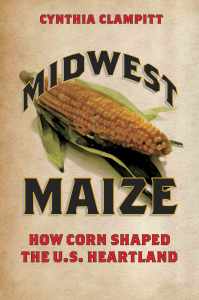Having posted photos and stories of the Corn Palace in Mitchell, South Dakota, I thought I should also mention that Mitchell is not by any means alone in honoring corn in a big way. Sure, it’s probably the most impressive and certainly the most complex of the monuments to corn here in the Midwest, but it’s not alone.
In Midwest Maize, I relate why Olivia, Minnesota, might actually feel justified in considering itself “The Corn Capital,” as the sign near the entrance to town announces, but simply being located in one of the country’s top four corn-growing states is a good starting point. This spring, I was invited to give my presentation—“How Corn Changed Itself and Then Changed Everything Else”—at the library in Olivia, which pleased me, given the area’s corn-centric economy. Someone in Olivia had supplied me with a photo of Olivia’s giant ear of corn, but when I visited, I was able to get my own shot of the big ear.
Several months earlier, I had visited another impressive monument to the golden grain in Dublin, Ohio, not far from Columbus. Here, an art installation titled “Field of Corn” features 109 concrete ears of corn that stand 6 feet, 3 inches tall. Worth noting is that it was not far from this area of Ohio that the Corn Belt actually started.
Clearly, the massive impact of corn on the Midwest is very much appreciated by those who live in the region.












